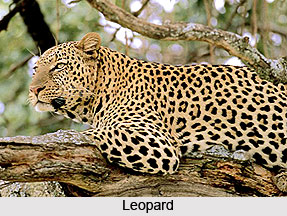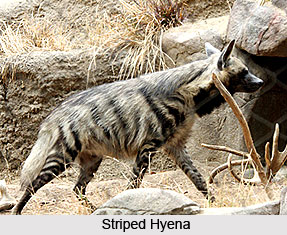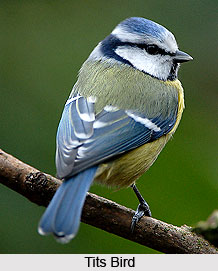 Fauna of Ranthambore Tiger Reserve is really wide and diverse. The unique climatic and vegetal features of this reserve have given rise to forests that are dry and open with little and stunted ground cover. These factors make wildlife viewing relatively easier on a safari. Fauna of Ranthambore Tiger Reserve comprises around 320 species of birds, both resident and migratory, over 40 species of mammals and over 35 species of reptiles. However, due to the dry climate there are not many species of amphibians in Ranthambore National Park. This park is renowned as the best place in the world to watch wild tigers.
Fauna of Ranthambore Tiger Reserve is really wide and diverse. The unique climatic and vegetal features of this reserve have given rise to forests that are dry and open with little and stunted ground cover. These factors make wildlife viewing relatively easier on a safari. Fauna of Ranthambore Tiger Reserve comprises around 320 species of birds, both resident and migratory, over 40 species of mammals and over 35 species of reptiles. However, due to the dry climate there are not many species of amphibians in Ranthambore National Park. This park is renowned as the best place in the world to watch wild tigers.
Besides tigers, the other wild animals found in Ranthambore Tiger Reserve are Leopards, Caracals, Jungle cats, Rusty Spotted cats. Fishing Cats and Leopard cats have also been reported here. The ungulates include Sambhar, Spotted deer (Chital), Blue bull (Nilgai), Chinkara (Indian gazelle) and Wild boar. The other large mammals that can be seen in Ranthambore Tiger Reserve are the Sloth bear, Indian fox, Jackal, the extremely occasional Wolf, very few Indian wild dogs (Dhole), Small Indian Civet, Palm civet, Common Indian and Ruddy mongoose and Striped Hyena.
Habitat wise distribution of fauna in Ranthambore Tiger Reserve -
Dangs: These are flat tabletop plateaus, surrounded by bold vertical cliffs. The soil depth is very shallow and there is hardly any water except in shallow constructed ponds and some moisture in depressions. In the summer season the dangs look deserted due to dry leafless Anogeissus pendula trees and lack of water. The main animals of the area are Chinkara, Nilgai, Leopards, Small cats, Hare, Fox, Jackal and Hyena. Avifauna is represented by Seed eating birds, Larks, Francolins, Quails, Sand grouse, etc. During rainy season Dangs are lush green with small water pools every where and the ungulates like Chital, Sambar and Wild boar visit the areas to feed on the profuse green fodder.
 Khohs: These are deep rocky seasonal streams cut up in the dangs. They are characterised by steep rocky slopes and cliffs, flat bottoms with deep and fertile soil. A number of water pools are found in the bottom and small perennial springs on slopes, even during the hot and dry summers. Khohs are cool, moist and alive throughout the year. The khohs are the main wild life areas of the reserve, especially outside the national park. Nearly all the species of mammals are found in these khohs. The avifauna is represented by Peafowl, Minivets, Flycatcher, Tits, Orioles and various other birds. All the species visit the upper plateau or dang area during night in search of food and especially during monsoons when khohs are wet and full of insects.
Khohs: These are deep rocky seasonal streams cut up in the dangs. They are characterised by steep rocky slopes and cliffs, flat bottoms with deep and fertile soil. A number of water pools are found in the bottom and small perennial springs on slopes, even during the hot and dry summers. Khohs are cool, moist and alive throughout the year. The khohs are the main wild life areas of the reserve, especially outside the national park. Nearly all the species of mammals are found in these khohs. The avifauna is represented by Peafowl, Minivets, Flycatcher, Tits, Orioles and various other birds. All the species visit the upper plateau or dang area during night in search of food and especially during monsoons when khohs are wet and full of insects.
Streams: These are areas where water flows and remains for a longer period than other areas. These constitute the drainage of watersheds and are found in folds of hills. Most of these finally join Chambal River. In these areas, even in the hot summer when other areas are dry and hardly have any natural water, some small pools exist. The area around the pools is characterised by a belt of green trees in the summer. These networks of riparian belts are the life line of wild life in this dry deciduous area. Such areas are home of all species of wild life, except Chinkara, which is essentially an animal of dry land. All animals are found within riparian area, except during rainy season when streams are fast flowing. From February till the onset of monsoon the riparian areas are extensively used by all the wild life.
 Valleys: The terrain of Ranthambore Tiger Reserve is hilly and there are large numbers of valleys in the area. These areas lie between two hills with flat bottom and rich soil and as a result the vegetation is good. Some water remains in the water channels in small water pools and provide nourishment to wild life during hot dry summer. Valleys are rich in wild life and almost all the species are found here. Tigers, Sambhar, Chital, Wild boar, smaller cats, Caracal, Chinkara, Nilgai, etc. are present throughout the year. In the valleys some good grasslands are also available which provide ideal cover for tigers and other smaller cats, along with ground birds. The avifauna is represented by Peacock, Partridges, Green Pigeons, Parakeets, Sparrows, and Warblers, etc.
Valleys: The terrain of Ranthambore Tiger Reserve is hilly and there are large numbers of valleys in the area. These areas lie between two hills with flat bottom and rich soil and as a result the vegetation is good. Some water remains in the water channels in small water pools and provide nourishment to wild life during hot dry summer. Valleys are rich in wild life and almost all the species are found here. Tigers, Sambhar, Chital, Wild boar, smaller cats, Caracal, Chinkara, Nilgai, etc. are present throughout the year. In the valleys some good grasslands are also available which provide ideal cover for tigers and other smaller cats, along with ground birds. The avifauna is represented by Peacock, Partridges, Green Pigeons, Parakeets, Sparrows, and Warblers, etc.
Ravines: Both banks of the river Chambal and Banas River are cut up by these ravines due to the sandy and easily erodible soil of these areas. These ravines are near about 50 metres deep with precipitous narrow channels. Major portion of the ravine areas have been levelled and ploughed by the villagers, but some areas are still wild. There are a few water holes in the ravines. Since the area is flooded during monsoon and remains dry during summer, the animal density of the area is generally lower. The main species found here are Chinkara, Nilgai, Wild boar, Hare, Hyena and many kinds of lesser mammals. The avifauna is represented by Peacock, River birds, Francolins, Sand grouse etc.
Wetlands: There are a few areas within the reserve where water remains throughout the year. Due to the presence of water these areas become the centre of activity of animals both wild and domestic. These water bodies contain a variety of aquatic fauna and flora, according to the depth of the water bodies. Along with aquatic fauna which includes turtle, crocodiles, fish, water birds, frogs, crabs and other small creatures, a lot of terrestrial fauna also use wetlands. The aquatic fauna constitutes an integral and important part of this ecosystem. Sambhar and Wild boar also feed on aquatic vegetation.
Thus the main wild and aquatic species found in Ranthambore Tiger Reserve are Tiger, Leopard, Jungle Cat, Caracal, Rusty Spotted cat, Sambar deer, Chital or Spotted deer, Nilgai or Antelope, Chinkara or gazelle, Wild Boar, Sloth Bear, Jackal, Hyena, Indian Palm Civet, Common Mongoose, Ruddy Mongoose, Indian Porcupine, Indian Hare, Indian Flying Fox, Marsh Crocodile, Bengal Monitor Lizard, Indian Rock Python, Indian Rat Snake, Indian Bull Frog, Skittering Frog, Common Indian Toad and more.



















